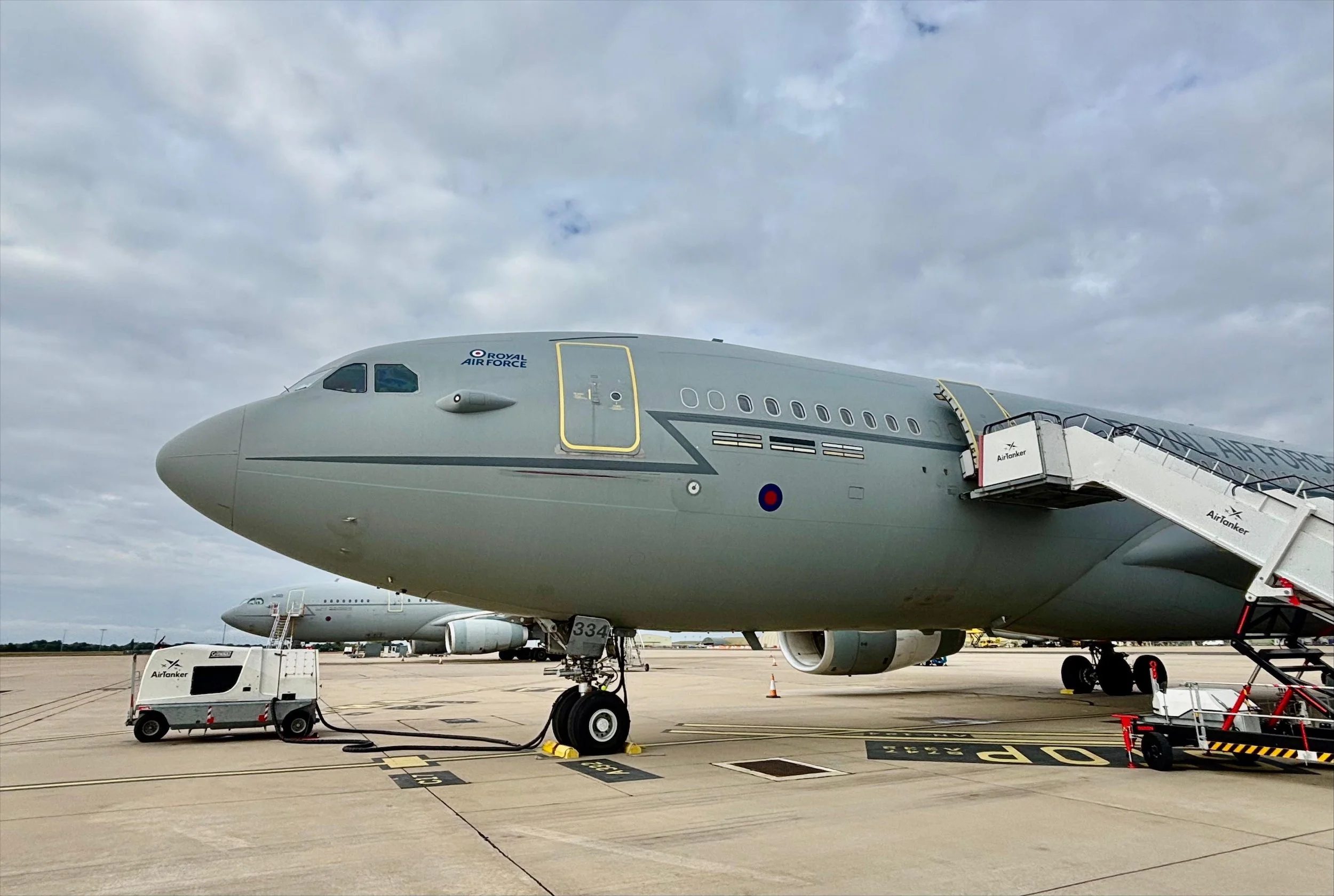Inside an air-to-air refuelling mission: A visit to RAF Brize Norton
This summer I joined the Honourable Company of Air Pilots on a visit to RAF Brize Norton, home of the RAF’s Voyager Multi-Role Tanker Transport (MRTT) fleet. The visit was hosted by 101 Squadron, who provided a detailed insight into one of the most technically demanding operations in modern aviation; refuelling aircraft in flight.
The Mission
Our flight, call sign Tartan 39, was operated by a 101 Squadron crew in an Airbus Voyager KC3 (ZZ334). The Voyager fleet, derived from the Airbus A330-200, provides the UK’s air-to-air refuelling capability under a long-term partnership with AirTanker, which also supports civilian operations when the aircraft are not required for defence tasks.
Voyager KC3 on the line at RAF Brize Norton, the RAF’s airborne refuelling station and one of the quiet enablers of UK air power.
After a detailed pre-flight briefing, we joined the crew on board and watched as they ran through the layered checks that precede every sortie, from fuel balancing and defensive systems to communications alignment with both UK and NATO networks. The day’s tasking involved supporting a group of Eurofighter Typhoons during a seven-hour mission over the North Sea.
Precision and practice
Air-to-air refuelling hinges on tight coordination between tanker and receiver. The Voyager uses a hose-and-drogue system mounted under each wing and once deployed, the hose stabilises using airflow and a small internal ram-air turbine that powers the drogue’s lights and pressure sensors. The Typhoon then approaches at more than 300 knots, aligning its probe with a target area barely a metre wide. Pilots must hold formation within a narrow envelope, often only a few metres from the tanker’s wingtips, while compensating for wake turbulence, crosswinds, and the tanker’s aerodynamic wash.
Once contact is made, the system checks pressure, confirms a “wet” connection, and begins transfer at rates up to about 1,500 litres per minute. The tanker’s mission system monitors flow, temperature, and hose tension in real time, adjusting the reel to keep a stable geometry as the two aircraft move through the air mass. Even small deviations can cause the drogue to oscillate, so pilots work continuously to stay within the authorised refuelling bracket.
These transfers dramatically extend a Typhoon’s endurance, enabling long-range combat air patrols, rapid repositioning, or support to NATO Quick Reaction Alert activities.
Despite the Voyager’s automation and the robustness of the hardware, the operation still demands sharp flying, clear radio discipline, and mutual trust between crews. Weather fronts, icing, or shifts in the jet stream can complicate closure rates and stabilisation. Training in these conditions ensures that when refuelling is required in operational settings, both tanker and receiver can execute with precision, even when margins are tight and conditions are far from forgiving.
RAF Brize Norton and the Voyager Fleet
Brize Norton is the largest station in the RAF, supporting around 8,000 personnel and handling the majority of the UK’s air mobility operations. The Voyager fleet forms a critical part of that capability. In addition to refuelling, the aircraft can carry 291 passengers or more than 45 tonnes of freight, and it can be rapidly configured for aeromedical evacuation or troop transport.
The flexibility of the platform reflects a broader shift in defence logistics - towards assets that can move quickly between military and humanitarian roles. Voyagers have supported missions from Operation Shader in the Middle East to emergency evacuations and NATO exercises. This dual-purpose role has made the aircraft one of the UK’s most valuable strategic enablers.
Typhoons over the North Sea
Operating at high speed and low separation from the Voyager, the jets practised the approaches, holds, and contact manoeuvres.
Observations
The day was a chance to see how modern air power depends on precision and process as much as on technology. The Voyager’s crew operate in a world where timing, communication, and calm professionalism matter more than spectacle.
Air-to-air refuelling may not capture the public imagination in the same way as fast-jet displays, yet it underpins almost every extended air operation the RAF undertakes. Without it, the reach of UK and allied aircraft would be sharply limited. The ability to project power, deliver aid, or respond to crises anywhere in the world depends on this quiet, disciplined capability.
Reflection
As we returned to Brize Norton, the impression that lingered was not of speed or noise, but of quiet competence. Air-to-air refuelling represents the connective tissue of modern air operations, a practice that extends range, sustains missions, and embodies the professionalism of those who make complex tasks appear routine.

